Planting an apricot in spring: how to plant a seedling correctly
Thanks to the work of breeders, apricot appeared in gardens not only in the southern regions of the country. With proper care, this culture is considered a long-liver, but the main condition for the full growth and development of the tree is the correct planting of the seedling in a permanent place, taking into account all the characteristics and needs of the culture.
About when and how to properly plant an apricot seedling in the spring in open ground - read further in our article.
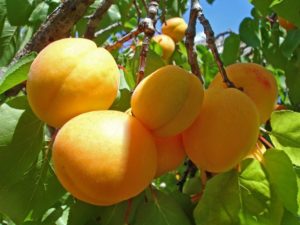
Content
- 1 When to plant apricots in spring, in what month: timing
- 2 How to properly plant an apricot in spring and what you need to consider
- 2.1 Requirements for planting material and preparation of a seedling for planting
- 2.2 Choosing a landing site
- 2.3 At what distance to plant
- 2.4 Soil composition
- 2.5 Planting pit depth
- 2.6 How and what to fertilize before planting (fill the planting hole)
- 2.7 Algorithm for direct planting of a seedling in the ground
- 3 Features of further care for apricots after spring planting in open ground
When to plant an apricot in spring, in what month: timing
The optimal period for planting apricots is early spring, before the buds enter the growing season (i.e.before the start of sap flow).
It should be borne in mind that apricot starts growing very early, so you should not postpone it.
At the same time, you should also know that planting a seedling must be carried out only when the air temperature is above zero, both during the day (preferably +5) and at night.
It is very good to plant seedlings with an open root system immediately after the snow melts, but the ground has not yet had time to warm up very much.
As for the approximate dates, depending on the climatic characteristics of the region, it is recommended to plant the apricot in spring from late March-April to early May.
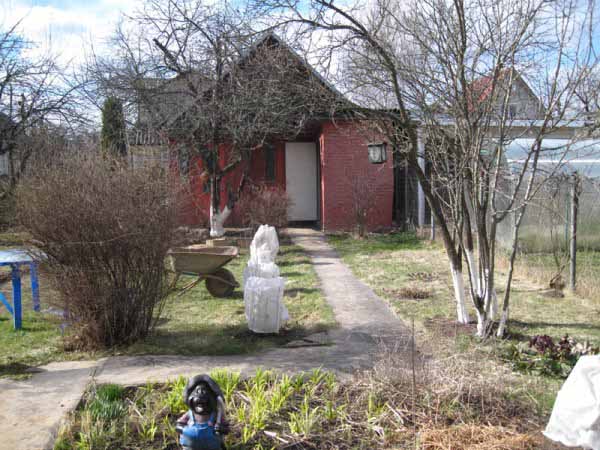
But first of all, it is necessary to focus on the weather conditions of the current season and take into account the condition of the seedling itself.
Thus, adherence to planting dates is the most important condition, since too early planting of an apricot threatens to freeze the tree in the event of a return of severe frosts. And later, it will entail a long and painful engraftment due to the active spring sun.
When is it better to plant - in spring or autumn
Important! It is also not recommended to plant apricots too early in the fall. the shoots must have time to ripen in order to survive the winter successfully.
However, if you are late, and frosts are expected within 1-2 weeks, then it is better to play it safe and postpone planting the apricot until spring.
By the way! Some gardeners plant apricots in containers in the fall and put them in the basement or cellar for the winter, others drop them in the garden. Whoever is comfortable and more like it.
- Throughout the season, the gardener has the opportunity to react in time to any negative factors that prevent the development of the seedling (drought, diseases, pests) and take measures to eliminate them.
- A sufficient amount of moisture in the soil in spring improves the survival rate of the tree, which reduces the period of its adaptation to a new place.
- When planting in spring, you have the opportunity to prepare a plot and a planting pit in advance (even from autumn), which will completely settle by spring, and therefore the probability of burying the root collar of the seedling will be excluded.
Thus, when planted in spring, the apricot tree has excellent chances to grow stronger during the season and be well prepared for the coming winter.
Note! Apricot seedlings with a closed root system can be planted all year round - from April to October, unless it is not entirely recommended to do this in the middle of summer, when it is very hot.
Planting dates in spring in different regions
Naturally, depending on climatic features, the timing of the spring planting of apricots in different regions is different:
- In the South of Russia, apricot can be planted in the second half of March or early April.
- Gardeners of the Middle Strip (Moscow region) should plant apricots no earlier than 2 decades or half of April.
- In Siberia and the Urals, it is possible to plant apricots in open ground only in late April-early May.

According to the lunar calendar in 2020
Choose the optimal date for planting seedlings can help you moon calendar.
So, favorable days for spring planting of apricots in 2020, according to the lunar calendar, are:
- in March - 26-29;
- in April - 11-15, 24, 25;
- in May - 2-10.

Of course, it is not always possible to get to the dacha on the appropriate days, so the main thing is not to plant apricots and any other crops on unfavorable dates according to the lunar calendar (the days of the Full Moon and New Moon, as well as the period when the Moon is in Aquarius, since this is barren and dry sign -italicized).
Unfavorable days, according to the lunar calendar, for 2020 for planting apricot seedlings in spring, the following dates are:
- in March - 9,19-21, 24;
- in April - 8,15-17, 23;
- in May - 7,13-14, 22;
- in June - 5,9-11, 21.
According to the lunar calendar, from the magazine "1000 Tips for Summer Residents".
How to properly plant an apricot in spring and what you need to consider
Before rushing to purchase and plant apricots, you should carefully approach the purchase of the seedlings themselves, and only then choose a suitable place for planting and be sure to properly prepare the planting pit. This will help new trees in the future to quickly adapt to a new place and grow.
Requirements for planting material and preparation of a seedling for planting
For planting, it is recommended to choose zoned apricot varieties that have a sufficient level of winter hardiness for your region.
It is necessary to purchase apricots for planting no older than 2-3 years of age, since at this age the seedlings easily tolerate adaptation in a new place.
You should also pay attention to the following points when choosing an apricot seedling:
Saplings can be either with an open root system (OCS), and with a closed one (in a container).
Of course, it is better for beginners to take seedlings in a container, and experienced gardeners can also purchase from ACS.
- The general appearance of the seedling should be healthy, without signs of wilting, damage from diseases or pests.
- The height of the seedling should be within 1-1.5 m: any deviation up or down indicates improper care of it or excessive application of nitrogen-containing fertilizers.
- The root system should be strong enough, that is, in addition to the main root, there should be 2-3 more lateral ones, the length of which should be 20-25 cm, while they should not be overdried and broken.
Even if you are buying a seedling with a closed root system, the lateral roots tend to stick out of the container.
- In the lower part, on the trunk, you should clearly see the grafting site (the joint of the rootstock and the scion), which will guarantee that this is a varietal tree, and not a wild.
As a rule, the vaccination is done by budding method (they also say "inoculated with an eye").
- It is also worth evaluating the quality of the upper part of the trunk (grafted part), the wood must be mature and strong, without any mechanical damage and cracks in the bark.
Important! It is highly desirable that the seedling does not have any signs of the beginning of the growing season, i.e. was in a dormant stage (the buds are asleep, there are no leaves).

However, seedlings with a closed root system (in containers) in the spring are often sold already in the growing season. In this case, you also need to carefully evaluate the appearance, especially the color of the leaves.
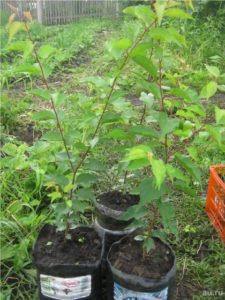
Video: how to choose an apricot seedling in spring
Preparing for landing
Immediately before planting, the roots of the seedling should be washed from the old soil, then dipped in a clay mash, and then the tips of the roots should be renewed by cutting them slightly.
And some gardeners recommend completely soaking the seedling in water for a day, which will help restore biological processes in the roots and saturate them with moisture.
Choosing a landing site
Apricot, being a southern light and heat-loving plant, requires more careful care, which means, first of all, choosing the right place for its further cultivation.
Therefore, when planting, preference should be given to sunny open areas, but at the same time protected from drafts.
Important! The culture does not tolerate even light shading, which threatens with poor winter hardiness of shoots, irregular fruiting, and negatively affects the taste.
An ideal option for planting apricots is considered to be a place that, from the north or north-west side, will be carefully protected from drying winter winds, for example, it can be your country house, some kind of outbuilding or a fence (By the way, a wall or a fence will still give reflected heat).
In this case, the tree itself, of course, should be placed on the south side so that it bathes in the sun for most of the day.
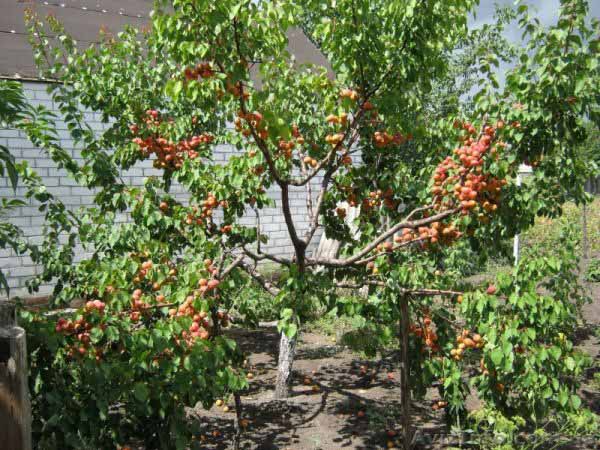
Culture does not like lowlands (it is simply colder there) and even more so wetlands, therefore, it is better to plant it in higher areas (even better, directly on the hills).
In other words, at the landing site moisture should not stagnate in the springwhen the snow melts. Otherwise, the plant will simply underpin the root collar, and it will die.
Note! The main condition for the successful cultivation of fruit crops with a "weak" root collar (which includes peach, apricot) in the zone of risky farming is planting on a hill (hill).
Also, when choosing a site, one should take into account the proximity of groundwater. The optimal level of their occurrence is considered to be 2.5-3 m.
Good lighting and a warm place are the key to fast and high-quality fruit filling.
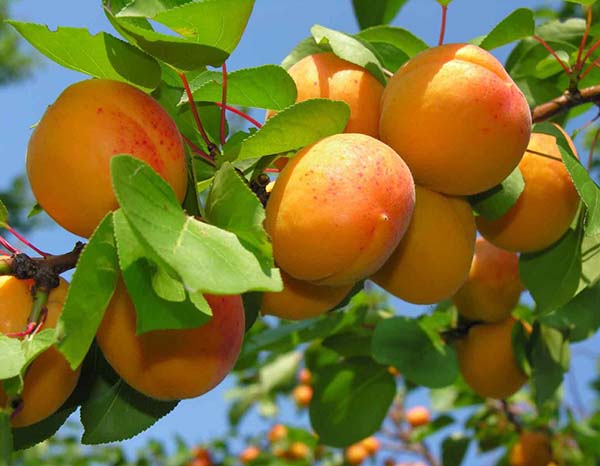
Video: how to plant an apricot in the Urals and Siberia so that it is guaranteed to bear fruit (landing on a hill)
In general, it is believed that apricot is an individual culture. However, for good pollination next to it, another 2-3 different varieties of apricot should be planted (the same varieties are not suitable for pollination), and it is necessary to have the same flowering and ripening period.
At what distance to plant
As the apricot grows, it forms a powerful tree with a spreading crown, therefore, if you plan to plant several seedlings at once or next to other plants, then initially it is necessary to maintain the necessary distance so that the trees do not interfere with and shade each other in the future.
Thus, it is recommended to plant apricots on such distanceso that between the trunks there is at least 3-4 meters, and even better 4-5 meters (as a rule, depending on the growth force of the selected varieties, the planting scheme can be from 4 to 5 m between rows and from 2 to 3 m in a row).
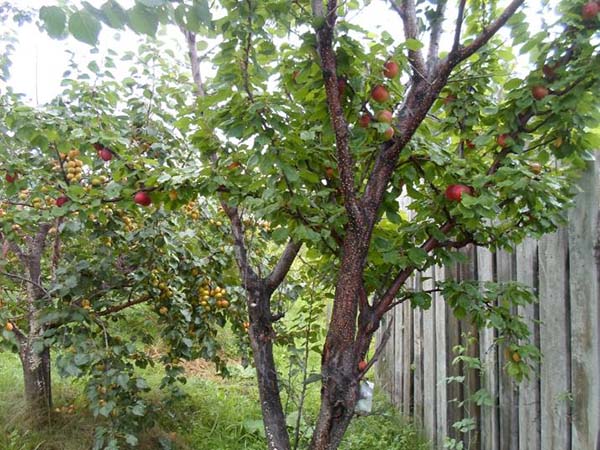
Remember! The closer you plant the seedlings, the more difficult it will be for you to control their crown in the future, in other words, mandatory pruning, including summer pruning, will be required.
Soil composition
Apricot will grow well on loose (which heats up well and easily passes water and air) and fertile land. Besides, soil acidity must be neutral.
Advice! In all areas, it is useful to add limestone or dolomite flour during spring or autumn loosening of the trunk circle.
Thus, the best option for growing apricots are loamy and sandy loam soil low acidity, and light black soil.
Less total for growing apricot suitable for sandy and clayey soilbut if you can create when landing good drainage (optimally from crushed limestone), then the culture will completely take root and will grow successfully even in such conditions.
Important! When planting apricots in overly sandy soil, add a little clay and more compost, and in clayey soil, add sand to help balance the soil.
Planting pit depth
To plant a tree, it is necessary to prepare in advance (dig and fill with nutritious soil) a planting hole, having done this in the fall, or at least 1-2 weeks before the procedure. During this period, the soil will just have time to settle to the desired level.
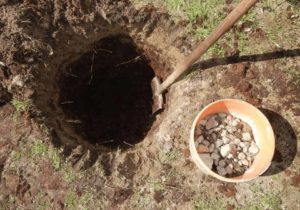
Planting pit depth for an apricot tree must be within 50-80 cm, like width - 50-70 cm.
Thus, the minimum size of the landing pit is 50 by 50 cm, and on average - 60 by 60 centimeters.
As a rule, a planting hole for a seedling closed root do 2 times larger than the container itself.
The bottom immediately fits drainage layer 10-15 cm from broken brick or small stones (optimal limestone), and then the prepared nutrient mixture is poured.
How and what to fertilize before planting (fill the planting hole)
In order for the apricot to easily adapt to a new place and strengthen for further growth, it is recommended to add the full range of nutrients when planting.
For this, the planting pit is filled with a specially prepared soil mixture (which is thoroughly mixed to a uniform consistency), which may include the following components (mineral and organic fertilizers):
- all horse fertile soil (upper 20-30 cm), which you removed when digging a hole;
- a bucket (8-9 kg) of good humus or compost;
- a bucket (8-9 kg) of non-acidic peat (if possible);
- a bucket (8-9 kg) of sand (if you have relatively heavy soil);
- 1-2 cups (200-500 grams) superphosphate or 400-600 grams of bone meal (organic phosphorus fertilizer);
- half or 1 cup of potassium sulfate (100-200 grams) or 2-4 cups (200-400 grams) wood ash (organic analogue of potash fertilizer).
Either instead of superphosphate and potassium sulfate, just use 300-400 grams of nitroammophoska (it contains 16% nitrogen, phosphorus and potassium) or even better diammophoska (optimal for autumn planting, because it contains 10% nitrogen and 26% potassium each and phosphorus).

Worth knowing! When planting a tree (even in spring), it is not necessary to specially add nitrogen fertilizers, since they stimulate vegetation to the detriment of root development (especially when planting in northern regions).
Important! However, many gardeners do not recommend at all to lay mineral fertilizers in the planting pit, but to apply them in the future, already as top dressing. Another thing is organic fertilizers such as compost, wood ash, bone meal.
Algorithm for direct planting of a seedling in the ground
Correctly carried out planting will allow the tree not only to quickly get used to a new place, but also to immediately direct all its forces to rooting. As a result, the seedling will be able to take root safely during the season and prepare for the coming winter.
Step-by-step instructions for planting an apricot in spring:
- Make a depression in the planting pit to fit the size of the seedling root system.
- In the case of planting a seedling with an open root system, add a small mound in the center of the planting hole.
If you are planting a seedling with a closed root system, then you do not need to make any mounds, but simply plant it in a prepared planting hole without disturbing the earthen coma.
- Drive in a wooden support (peg) to support the young seedling in the future.
- Place the seedling in the center of the mound and spread the roots along its (mound) sides.
Important! If you have a seedling that was grafted with an eye (budding), then the budding site (eye = new shoot that grew from the grafting) should face north and the cut site should face south.
- Sprinkle soil over the roots while shaking the seedling to eliminate voids between the roots.
- Compact (tamp) the soil, starting from the edges at the base of the seedling.
In this case, the root collar (the place where the first root originates from the trunk) should be located 3-5 cm (you can simply attach 2 fingers) above the soil level.
Do not confuse the root collar with the grafting site! The vaccination is even higher.
- Next, you need to make a hole (roller) along the diameter (perimeter) of the trunk circle 10 cm high.
- Spill abundantly with water, pouring out at least 2-3 buckets (pour out gradually - wait for it to be absorbed and add more).
- Tie the apricot to the prepared support with a soft twine and secure in the correct position.
- Smooth out the roller, loosen the soil in the near-trunk circle and mulch it with peat, humus or compost.
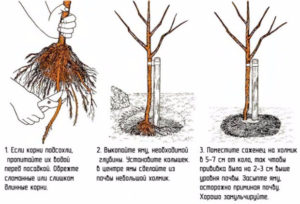
Worth knowing! Mulch should not be laid close to the trunk of the seedling, as this can cause the bark to undergo heating, and, consequently, cause the development of fungal diseases.
Video: planting an apricot seedling with a closed root system
Features of further care for apricots after spring planting in open ground
Immediately after planting, the apricot seedling must cut and shorten the crownto level the root system with the aboveground part.
How to do it correctly (start shape apricot tree), read in our article on spring pruning apricot.
Video: pruning apricot after planting
In the future, for the successful rooting of the apricot, it is necessary to monitor the soil moisture and, if necessary (in the spring and autumn, water 2 times a month, and in the hot period - 1 time in 7-10 days) carry out abundant watering.
Advice! Either make a new hole every year, or initially not very deep, so that moisture does not accumulate in it in the early spring period and the root neck does not get wet.
At the same time, the soil should not be allowed to dry out, but it should not be poured (especially waterlogging is harmful at the end of the growing season - August, since it delays the ripening of annual shoots, and the plants do not have time to prepare for winter).
Advice! To determine that it is time for watering, you can do the following: dig a hole on the bayonet of a shovel (25-30 cm), and then take a handful of earth from the bottom of the hole - if it is dry, then urgent and abundant watering is required.
Additional top dressing it is not worth it this year, since the seedling has already received all the necessary complex of nutrients even during planting, and it should be enough for 2-3 years.
Although, if desired, the trunk circle can be immediately mulched with humus or compost with a layer of 2-3 cm.However, in no case you can not use manure, and also shovel a pile directly onto the tree trunk.
Throughout the season, it is recommended to closely monitor the condition of your tree so that it is not suddenly struck by any diseases and pests.
By the way! Two-year-old apricots can begin bearing fruit on small, annual branches. However, this should not be allowed after planting so that the seedling hardens better.
And in the future, in any case, you will need to conduct annual treatments of apricots with fungicides and insecticidesso that protect the tree from diseases and pests.
By the way! The site has a detailed article about how to properly spray fruit trees and berry bushes in the spring against diseases and pests.
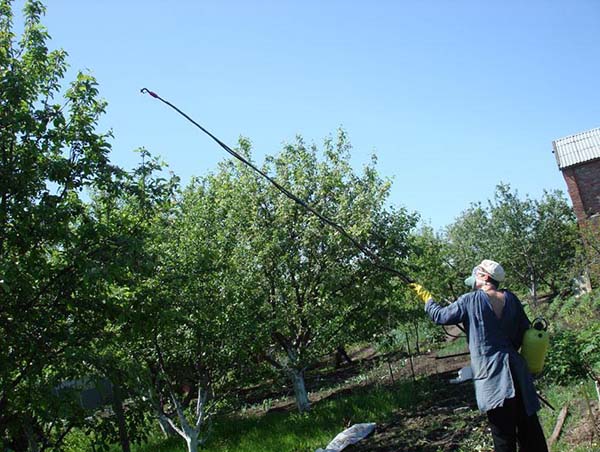
Also, don't forget correctly prepare (cover) the apricot for winter.
In the spring it will be necessary to quickly remove the shelter after the snow melts. The fact is that the apricot is not afraid of small frosts, however, it can still be locked up under cover.
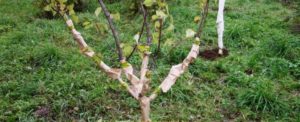
By the way! In the future, if you do not like the planted variety, you can re-graft or plant and grow from seed and already for a new seedling inoculate a neighbor's variety or somewhere else to get the cherished cuttings (grafts).
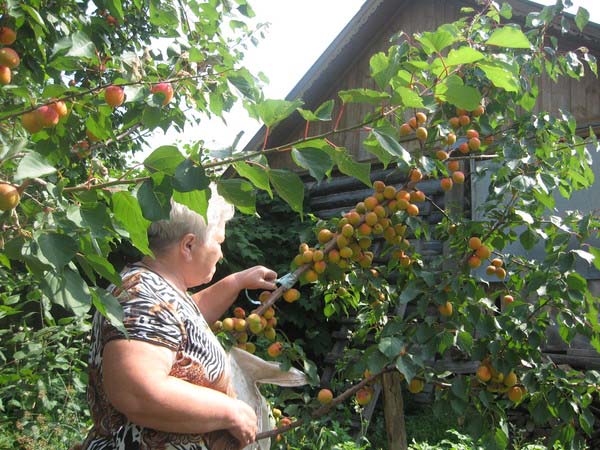
Thus, now you know how to properly plant an apricot in spring in your garden, so that it quickly takes root in a new place and in a couple of years begins to delight you with abundant and tasty harvests. Go for it!
Video: features of planting apricots and further care

